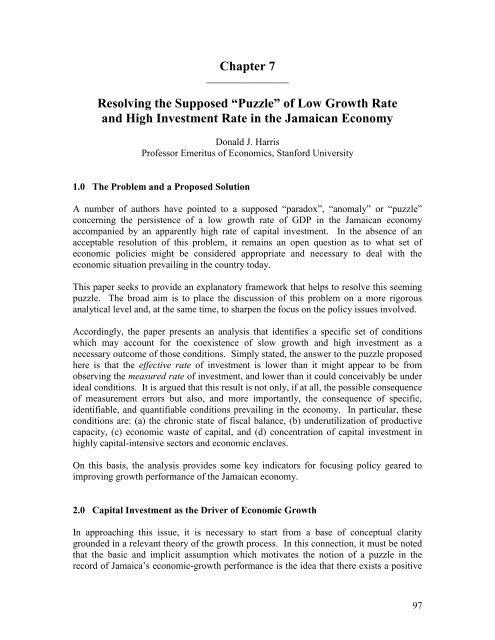PIOJ Growth-Inducement Strategy - Planning Institute of Jamaica
PIOJ Growth-Inducement Strategy - Planning Institute of Jamaica
PIOJ Growth-Inducement Strategy - Planning Institute of Jamaica
You also want an ePaper? Increase the reach of your titles
YUMPU automatically turns print PDFs into web optimized ePapers that Google loves.
Chapter 7<br />
_________________<br />
Resolving the Supposed “Puzzle” <strong>of</strong> Low <strong>Growth</strong> Rate<br />
and High Investment Rate in the <strong>Jamaica</strong>n Economy<br />
Donald J. Harris<br />
Pr<strong>of</strong>essor Emeritus <strong>of</strong> Economics, Stanford University<br />
1.0 The Problem and a Proposed Solution<br />
A number <strong>of</strong> authors have pointed to a supposed “paradox”, “anomaly” or “puzzle”<br />
concerning the persistence <strong>of</strong> a low growth rate <strong>of</strong> GDP in the <strong>Jamaica</strong>n economy<br />
accompanied by an apparently high rate <strong>of</strong> capital investment. In the absence <strong>of</strong> an<br />
acceptable resolution <strong>of</strong> this problem, it remains an open question as to what set <strong>of</strong><br />
economic policies might be considered appropriate and necessary to deal with the<br />
economic situation prevailing in the country today.<br />
This paper seeks to provide an explanatory framework that helps to resolve this seeming<br />
puzzle. The broad aim is to place the discussion <strong>of</strong> this problem on a more rigorous<br />
analytical level and, at the same time, to sharpen the focus on the policy issues involved.<br />
Accordingly, the paper presents an analysis that identifies a specific set <strong>of</strong> conditions<br />
which may account for the coexistence <strong>of</strong> slow growth and high investment as a<br />
necessary outcome <strong>of</strong> those conditions. Simply stated, the answer to the puzzle proposed<br />
here is that the effective rate <strong>of</strong> investment is lower than it might appear to be from<br />
observing the measured rate <strong>of</strong> investment, and lower than it could conceivably be under<br />
ideal conditions. It is argued that this result is not only, if at all, the possible consequence<br />
<strong>of</strong> measurement errors but also, and more importantly, the consequence <strong>of</strong> specific,<br />
identifiable, and quantifiable conditions prevailing in the economy. In particular, these<br />
conditions are: (a) the chronic state <strong>of</strong> fiscal balance, (b) underutilization <strong>of</strong> productive<br />
capacity, (c) economic waste <strong>of</strong> capital, and (d) concentration <strong>of</strong> capital investment in<br />
highly capital-intensive sectors and economic enclaves.<br />
On this basis, the analysis provides some key indicators for focusing policy geared to<br />
improving growth performance <strong>of</strong> the <strong>Jamaica</strong>n economy.<br />
2.0 Capital Investment as the Driver <strong>of</strong> Economic <strong>Growth</strong><br />
In approaching this issue, it is necessary to start from a base <strong>of</strong> conceptual clarity<br />
grounded in a relevant theory <strong>of</strong> the growth process. In this connection, it must be noted<br />
that the basic and implicit assumption which motivates the notion <strong>of</strong> a puzzle in the<br />
record <strong>of</strong> <strong>Jamaica</strong>’s economic-growth performance is the idea that there exists a positive<br />
97
















